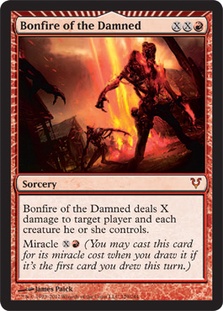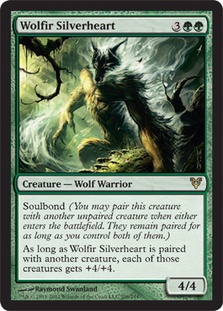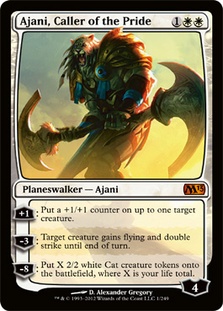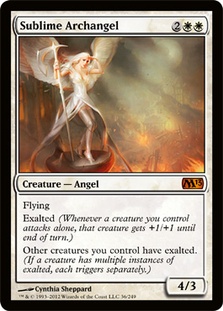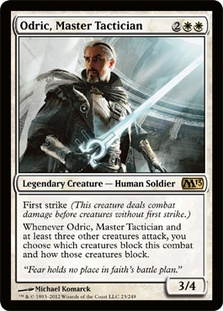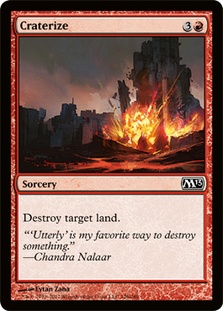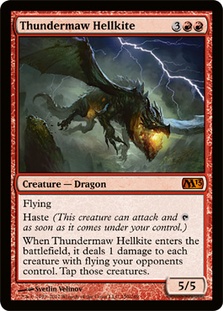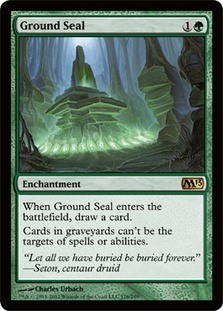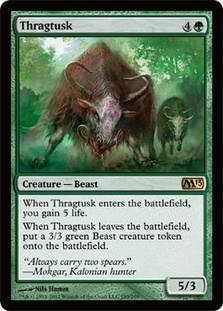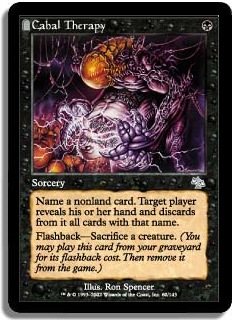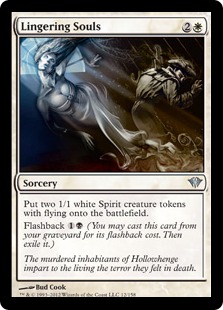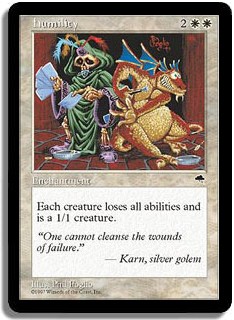"What’s in a name? That which we call a Delver of Secrets by any other name would blind flip just as often."
-William Shakespeare, "Romeo and Brewliet"
The dastardly D o’ S has really shaped Standard for the last six months. Its dominance has led to many of us hearing the following phrases a lot.
"If you want to win, play Delver."
"Why are you wasting your time playing these other decks? Just play Delver, the best deck."
"You’re handicapping yourself if you don’t just play Delver"
I cannot tell you how many times I’ve heard these words over the past year, from people whose opinions I respect. For a while I listened to them. For a while I tried to win with Delver and failed. It took some time and a lot of losing, but I finally learned an important lesson.
They were wrong.
Maybe they should play Delver. Maybe they are handicapping themselves by playing something else. But to suggest that everyone is the same or that someone is foolish for playing a different deck is completely incorrect. I was handicapping myself by playing Delver, not by playing other decks.
Not everyone is wired the same way. Not everyone is good at playing the same decks. Even people who have played the game at the highest level for 10+ years have certain deck choices they perform better with. For a while I considered it a shortcoming that I couldn’t find success playing Delver. Every time I played Delver in a tournament and lost, the message I told myself was that the best players were playing it and winning, and since I’m playing it and losing, I’m bad at this game.
Granted, I am bad at this game, but that’s beside the point.
The truth is that it’s not a shortcoming that I suck at playing Delver. Delver is simply a deck that doesn’t fit into my skillset when it comes to Magic. That is perfectly acceptable. I have embraced the fact that I can’t play the deck. Now that I’m free from the shackles of the Insectile Aberration, I’ve found Standard to be a lot more fun and enjoyable to play.
The idea that purely from practice Joe Q. Rando can become a master at playing every deck is pretty absurd. I’m sure there are some truly gifted players who can play every archetype with the highest level of skill, but they are the exception, not the norm. The majority of good players, even top-level professionals, are known for playing certain types of decks for a reason: those are the decks that they excel at playing.
So often the message we are fed is that to become better at Magic we need to play different archetypes. "You’ll never improve if you don’t learn how to play Mono-Green Control!" they say. While there is a good point behind these statements—that you should try out new decks to broaden your range of skills—oftentimes what we end up losing sight of is that sometimes the best thing you can do to succeed is to simply play a deck you are comfortable with and skilled at playing, even if it’s not the consensus "best deck."
Thomas Edison once famously said: "I haven’t failed; I’ve just found 10,000 Delver of Secrets that didn’t flip." According to historians, after making this statement he raged at his Magic Online opponent, sold his Delver deck, picked up Naya Aggro, and went 3-1 in the next Daily Event. Edison recognized that he wasn’t getting it done with Delver and made the transition to a more Bonfire-oriented deck.
And on that note:
Naya Aggro In Standard
Creatures (32)
- 4 Birds of Paradise
- 3 Borderland Ranger
- 3 Hero of Bladehold
- 4 Blade Splicer
- 4 Avacyn's Pilgrim
- 3 Strangleroot Geist
- 3 Thalia, Guardian of Thraben
- 4 Huntmaster of the Fells
- 4 Restoration Angel
Lands (24)
Spells (4)

This is the Naya list that I’ve been playing lately. In addition to being fun to play, this is the deck I have had the most success with as well. 24 lands, 32 creatures, 4 Bonfires. What more do you need?
Rather than water the deck down with Birthing Pod and various Tutor targets, I wanted to just play a clean, straightforward deck that maximizes on all the best cards. While a Birthing Pod deck is going to perform better when it draws Pod, this Naya deck is going to be much more streamlined in the other games.
Four Bonfire of the Damned. This card is ridiculous. Anytime you miracle this card against another creature deck, the game usually just ends on the spot. Even against more controlling decks, the card still has applications. I generally keep in 2-3 copies against U/W/x control decks because they almost always have Timely Reinforcements and/or Lingering Souls and they usually play in such a way that they expect those tokens to soak up damage.
To give an example, let’s say I’m on the draw against a U/W/x control opponent. I play Avacyn’s Pilgrim on turn 1 and Borderland Ranger on turn 2. He follows it up with a Timely Reinforcements on turn 3. On my turn 3 I cast Hero of Bladehold. Now, he might have a Day of Judgment in hand, but he’s likely not going to cast it here because he wants to get value out of his Timely Reinforcements first. If I Bonfire away his soldiers, he’s going to take twelve damage from just those three creatures, and that is damage he is not expecting to take.
One major difference between this deck and most other Naya lists is that I’m playing three Hero of Bladehold. The list I originally started with (Martin Juza’s list from GP Manila) played two Heroes in the sideboard. Every time I sided the card in I was very impressed with how it performed, and I started siding it in against more and more decks until I decided to just run it in the maindeck.
Juza’s list ran three Geist-Honored Monk where I have Hero in its place. Geist-Honored Monk is much better against Delver and has awesome synergy with Restoration Angel, but Delver has been on the decline in popularity since GP Manila, so I would rather run a higher impact card against other decks. Bonfire’s newfound popularity also makes Geist-Honored Monk much worse since the Monk has a much harder time surviving one.
Hero also has great synergy with your own Bonfires. Being able to clear your opponent’s board is so much more devastating when you also take out the vast majority of their life total as well in the process. Hero also plays very nicely with Gavony Township, which also happens to come at the perfect spot in the curve.
One thing I want to note about the sideboard is two copies each of these five-drops. This is a bit brutish and I’m sure that I can streamline my sideboard a bit better, but these five-drops all are very useful in a variety of matchups.
Silverheart is awesome against any G/R deck, be it G/R Aggro or Wolf Run variants. Silverheart actually lets you compete with Titans, something the deck cannot otherwise do.
Zealous Conscripts is great against any Titan or planeswalker based deck, essentially. Against ramp, you want to get their life total as low as possible, so if they play a Titan they are just dead to Conscripts. Against a control deck, Conscripts serves as a good hasty threat to provide surprise damage and is also strong against any planeswalker. Keep in mind that you can use Zealous Conscripts to give one of your own creatures haste, which is occasionally relevant.
Geist-Honored Monk is basically for Delver. She provides immediate value, so she’s relevant even if she gets immediately hit with a Vapor Snag, and her Spirits provide great chump blockers for things wearing equipment or Angels. The Monk is also usually big enough to attack through defending Restoration Angels, and not a lot of the other creatures can say the same. I also tend to side this in against control decks as an "army-in-a-can" creature that can demand a board sweeper by itself, especially in conjunction with Gavony Township.
A few writers have come out recently to suggest that G/R Aggro is the best deck in Standard. The main reason for this assertion is the power of Bonfire of the Damned. This Naya deck has a very similar game plan to the G/R deck, but it sacrifices a bit in consistency for the added utility of cards like Blade Splicer and Restoration Angel. I can’t really say if one deck is more powerful than the other, but I definitely think that the basic formula of aggressive value creatures with Bonfires is the best thing you can be doing in Standard right now, whether it is G/R or Naya.
The deck is quite good now, but the best thing is that it only gets better with M13. Let’s talk about a few cards that I think have a chance to see some play in Naya post-M13.
I think Ajani will fit great into the deck. I am not sure how many copies I would play, but based on how amazing activating Gavony Township is, I can imagine his +1 being very strong. And I cannot wait to use his -3 ability on a Hero of Bladehold. Giving evasion to a creature with such a dominating combat presence is going to end games very quickly.
And while Ajani seems good with Hero of Bladehold, I ultimately think his abilities synergize best with another 2WW mythic…
There is some conflict between this card, which wants you to attack with just one creature, and Gavony Township, which wants you to send the team, but overall I think this is an awesome fit to the deck. Avacyn’s Pilgrim and Birds of Paradise let you cast Sublime Archangel earlier than you normally would, and then they both have awesome synergy with it by also gaining exalted to boost your lone attacker.
Sublime Archangel also seems amazing with Ajani since you can give whatever creature you want to attack with flying AND double strike, two abilities that interact profitably with exalted. It’s like a build-your-own Rafiq, and I can see this deadly duo surprise one-shotting people from seemingly "safe" life totals.
While this card has gotten some press, I actually think as a whole it’s being underrated. I can’t stress enough how powerful I feel this card is. It feels like a Hero of Bladehold that has a form of haste attached to it. Granted, it is easier for your opponent to answer one creature than a whole mass of them, generally speaking, but this card can output a lot of damage very fast.
Odric Astley, Master Tactician is never gonna give you up. He’s also competing with Hero of Bladehold, Restoration Angel, and Sublime Archangel for the hotly contested slot of "which 4 CMC white creature with a combined seven power and toughness and a relevant combat ability are you going to play?" You might have to let him down. Right now, it looks like Odric is worse than the other options, but he seems insanely good at winning creature stalls so perhaps he will see play eventually for breaking open the creature mirrors. You can force your opponent into bad blocks or no blocks, whichever is more profitable for you.
This barely gets the edge over Demolish because the majority of players feel it has a bigger impact name. It’s certainly in a ‘hole’ other league.
I actually think this card is worse than everyone else does. It seems to me to be about the same power level as Zealous Conscripts. That’s not bad by any stretch, as Conscripts is a very strong card, but at the same time I don’t think it’s going to be a huge format-defining card. I think I’d rather have Conscripts.
I find it surprising how few people have talked about this card. This seems like a solid sideboard card for green decks to combat Snapcaster Mage and Unburial Rites strategies. This is a great answer to Frites for decks that otherwise can never beat Unburial Rites on Elesh Norn. This is Nihil Spellbomb for green decks. You spend two mana to draw a card and slow down your opponent’s game plan a bit. This isn’t a flashy, high-impact card, but I can see it being a very solid role-player.
This seems like a great card to replace the Geist-Honored Monks with. I’m not sure if Thragtusk is really any better against Delver than GHM, but it makes up for that by having great applications in other matchups, such as against Zombies. I would run one copy of this card maindeck in any Birthing Pod deck, and I’d like at least two in the sideboard of this Naya deck.
GP Atlanta, Stoneblade, and Speed of Play
Changing gears for a moment, last weekend was GP Atlanta, which if I am not mistaken was the first Legacy GP since GP Indianapolis.
I decided to sleeve up my trusty Esper Stoneblade deck for another attempt at glory. Much like the last time I played Stoneforge Mystic (for the SCG Invitational), I elected not to play Lingering Souls since it’s a very hit or miss card. Unfortunately, the only "miss" was me really missing its presence in my 75.
Lingering Souls is really bad against combo decks and mediocre in some of the fair matchups, but it really shines in matchups like the Stoneblade mirror. What I underestimated was just how prevalent Stoneforge Mystic was going to be at this tournament.
I played a full 50% of my matches against Stoneblade, and as I didn’t have Lingering Souls and they all did, I predictably went 1-2 in those matchups.
While it was a mistake to not have Lingering Souls, another big mistake I made came in round 6. At 5-0 I got paired against RUG Delver. Unfortunately, our match went to time and ended up as a draw. This is where the tournament ended for me. After I drew here, I played Stoneblade twice in the draw bracket. Both of those matchups also went to time. I lost both.
I ended up playing three consecutive matches that went to time. My match in round 7 would have also ended as a draw, but I had taken more time than my opponent and since I was dead on board with no outs, I conceded to him. He had the win if we had another turn. My round 8 match was still in game 2 when time expired, and as I couldn’t kill my opponent and had lost game 1 I ended up losing the match 1-0-1.
What was the big mistake I made in round 6? Playing slowly! If I had played faster I would have won this match, as I had my opponent completely locked out of the game. That would have kept me out of the draw bracket and hopefully out of the Stoneblade with Lingering Souls bracket. As I really like Stoneblade a lot against the rest of the field, I feel like I would have had a pretty good shot of advancing far in the tournament.
The lesson to learn here is that if you’re going to play a deck like Stoneblade, especially if your deck is not well-suited in the mirror match (or against other slow control lists), it’s essential that you play quickly enough to avoid taking unintentional draws. Don’t wait until game 3 when the clock is winding down to have both players play quickly. By then it’s too late.
Oftentimes a draw is as good as a loss. For me, in this tournament, a draw was probably worse than a loss since it paired me up against back-to-back bad matchups that knocked me out of Day 2.
I had a conversation with the ancient Gerry Thompson where we basically came to the conclusion that I have had more unintentional draws in the last year than he’s had in his entire Magic playing career. How many tournaments have I costed myself because of this? If you are like me in that you pick up a number of unintentional draws, I would strongly consider spending some time trying to change your play to avoid this. It can only hurt your chances of winning a tournament.
I know I will be paying closer attention to my speed of play in the future.
As for where I’d like to take Stoneblade next, I want to combine the interaction between Cabal Therapy and Lingering Souls with the interaction between Lingering Souls and Humility. Ali Aintrazi had Lingering Souls and Humility in his GP Atlanta deck, but I felt like he was missing the piece of the puzzle that is Cabal Therapy.
Cabal Therapy, especially with other hand disruption like Inquisition of Kozilek or Thoughtseize, is very effective at completely dismantling your opponent’s game plan, especially when you can reliably flash it back. Lingering Souls provides the fodder for this.
Humility makes Lingering Souls an actual four for one against creature decks, and a Germ token with a Batterskull equipped is a 5/5 with vigilance and lifelink, so Humility interacts fairly favorably with both Lingering Souls and Batterskull. Humility is also amazing against the Show and Tell decks and Reanimator as neither of those decks can possibly beat the card if it enters play.
When you combine the entire package, you get something that looks like this:
Creatures (8)
Planeswalkers (2)
Lands (24)
Spells (26)

I can’t wait to try this out at the next Legacy tournament I attend.
I also can’t wait for the M13 Prerelease. I am really, really hoping that I open a Battle of Wits, because I will play that card and every other card in my pool along with enough lands to make it work. If my first rare is a Battle of Wits, I am just putting the rest of the cards from the packs into my deck without even looking at them. The Prerelease is a great time for discovery, and what better way to discover the set than by not even knowing what’s even in your deck!
I hope you have as much fun at the Prerelease as I plan to. Until next time…
Thanks for reading,
BBD on Magic Online
@BraunDuinIt on Twitter

